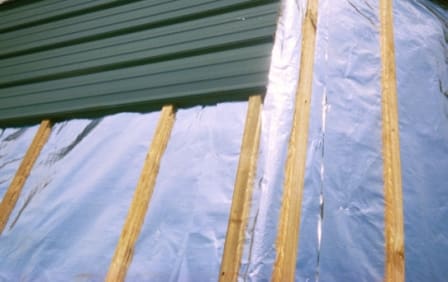FI-FOIL® CEO Bill Lippy was asked by Metal Construction News to write an article on the science of radiant barriers. See the results below:
Radiant Barrier Systems and Reflective Insulation Systems
Choosing the right insulation product or insulating system in your building is a critical step to saving money, improving comfort and being environmentally responsible. Each type of building provides unique challenges.
Unique Challenges to Metal Buildings
Metal buildings, particularly metal roof systems, offer an opportunity to utilize different strategies for incorporating insulating materials. Steel is an excellent conductor and can store and radiate unwanted heat in summer conditions. In winter conditions, condensation can result from an improperly insulated cold metal roof or purlin.
By combining traditional insulation with a radiant barrier or insulation that includes low emittance surfaces, the building owner can minimize radiant heat gain in the summer and loss in the winter. This improves comfort and energy savings.
Radiant Barrier Science
A radiant barrier or reflective insulation, as defined by the American Society of Testing and Materials (ASTM), is a reflective, low-emittance surface in which the emittance is 0.10 or less. A radiant barrier system utilizes ventilation to improve performance in summer conditions. An example of a radiant barrier system is a ventilated cavity below a metal roof application; this is common in residential re-roof applications.
Reflective insulation systems utilize the same technology. The difference is that reflective insulations are installed to enclose a building cavity. An example of a reflective insulation system in a metal building is a reflective product installed on the bottom of the metal purlins enclosing the 6- to 8-inch purlin and beam section. In both systems, the thermal performance, or the reduction of radiant heat transfer, is directly proportional to the surface emittance of the low emittance material.

Emittance measurements of all materials range from zero (no radiant heat transfer) to one (that of a black surface or complete radiant heat transfer). Common building materials, such as wood, masonry, and fiberglass insulation, have surface emittances that typically range from 0.82 to 0.90 and, therefore, have high radiant heat transfer rates. Radiant barriers and reflective insulation products are low on the scale, typically 0.03 to 0.06 and thus radiate significantly less energy from the product surface(s).
Consequently, radiant barriers and reflective insulation prevent significant heat loss and gain through the building envelope. Radiant barriers typically incorporate ventilation and thus are not measured in terms of R-value. Instead, software for calculating building performance accounts for the benefits of radiant barriers in attic spaces by including a reduction in ceiling heat flux and a reduced load on HVAC ducts. Reflective insulation systems are installed in enclosed cavities, encapsulating air spaces, so R-values can be measured with a Hot Box Apparatus, or calculated using ASTM methodology or from tables from the ASHRAE Handbook of Fundamentals. How much can radiant barriers save? Studies have proven the performance of radiant barriers in metal construction. The Florida Solar Energy Center performed side-by-side tests for Auburndale, Fla.-based FI-FOIL® Co. using a base case roof (dark shingles) to a metal roof radiant barrier system. The average mid-attic air temperature reduction for the roof with the radiant barrier was 19 degrees in the summer and the average ceiling heat flux reduction was 43 percent. The metal roof radiant barrier system resulted in 11 percent more cooling savings than the dark shingle roof system.
Case Study
Fastenal Co. in Shelby, N.C., was operating out of an older metal warehouse insulated with a standard vinyl faced fiberglass batt. The building was not energy efficient and the vinyl facing on the old insulation was torn and hanging in areas of the retail showroom.
Fastenal district manager Ryan Sanderford opted to install the RetroShield® System manufactured by FI-FOIL®. It is specifically designed to reduce the effects of radiant heat transfer, provide some air sealing and complete the building with a clean, finished look. This system can be installed on new and existing metal buildings and is easy to install. It covered the existing insulation, improving the indoor appearance of the showroom. Thermal performance of the existing system was improved by an additional R-12. The new material reduced radiant heat transfer, and the system covered the bottom of the metal purlins and sealed off some unwanted air infiltration. Covering the bottom of the metal purlins with even a small amount of insulation can make a big difference in the thermal performance of the building.
Fastenal’s average energy consumption for the second quarter 2009 compared to the second quarter 2008 has been reduced by 2 percent. This is proof that radiant barrier systems in metal roofs and reflective insulation systems in metal buildings are an effective way to increase energy efficiency and comfort.
Bill Lippy is president of Auburndale, Fla.-based FI-FOIL® Co. To learn more, call (800) 448-3401.

